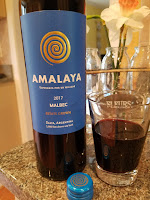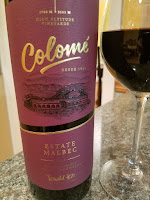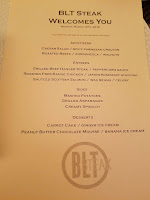 Wines of Argentina
Wines of Argentina has designated Friday April 20th as
Malbec World Day so why don't we delve into the world's most popular producer of Malbec wine. In the land of contrast there are three major wine producing regions: Salta, Valle de Uco (in Mendoza), and Patagonia. The first two are high altitude regions with the Uco Valley anywhere from 2,800 to 5,600 feet and Salta, the most extreme, up to 10,000 feet above sea level. The cold temperatures usually associated with higher elevations are mitigated by the relatively warmer temperatures from it's lower latitude and the increased levels of sunlight and UV exposure. On the other hand, Patagonia averages only 1,000 feet but has its own extreme features. This is a cooler desert climate that is warmed by the "La Zonda" winds driving through the eastern slopes of the Andes. Thus, in all three regions there is a strong diurnal temperature variation, plenty of sunlight, and well drained soils - translating to well formed wine grapes. And in preparation for Malbec World Day I received several samples of Argentinian Malbec wine.

Colomé Malbec Salta 2015 ($25) -
Bodega Colomé is one of the oldest working wineries in Argentina and home to the highest vineyards in the world in Salta's Calchaquí Valley. The winery was established in 1831 when the vineyards were first planted on original rootstock imported from Bordeaux -- and these vines are still bearing fruit today. Now a member of the
Hess Family Wine Estates, Colomé consistently produces well made wine like this dense, full bodied, and velvety edition. The wine's finish shows white pepper, acids, and noticeable, but approachable tannins.
 Amalaya Malbec Salta 2016
Amalaya Malbec Salta 2016 ($16) - a blend of 85% Malbec 85%, 10% Tannat, and 5% Petit Verdot.
Bodega Amalaya wines began as an experiment at Bodega Colomé in order to find alternative sourcing and varieties for Malbec and Torrontés blends. Donald Hess instructed his researchers to seek land where no vines had ever been planted the workers labelled the quest using the Inca expression Amalaya meaning 'Hope for a Miracle'. This wine is a great value and is fruit forward with dusty, spicy, and vanilla characters from mild oak treatment (25% aged 8 months in French Oak).
 2015 Susana Balbo Signature Valle de Uco Mendoza Malbec
2015 Susana Balbo Signature Valle de Uco Mendoza Malbec ($20). This wine is from the Uco Valley's
Altamira wine region which is at the southern tail of the Uco Valley on the banks of the Tunuyan river. The location's hot sunny days The vines' location promotes ripening, adding weight and complexity to the wines and the cooler nights provide the development of acidity and aromatics. This wine displays these characters with ripe juicy black fruit, structure, slight spice and chalk, and a fresh yet silky finish featuring subtle tannins
 2015 Domaine Bousquet Malbec Grande Reserve
2015 Domaine Bousquet Malbec Grande Reserve ($25) - This 85% Malbec, 5% Cabernet Sauvignon, 5% Merlot, 5% Syrah blend is made from vineyards planted in the most northern and highest elevation (4,000 ft) in the Uco Valley:
Tupungato, Alto Gualtallary. These conditions breed acidity and skin tannins which are prevalent in this organic wine. There is also plenty of structured velvety texture, floral aromas, and dark dried berry flavors. A fantastic wine.
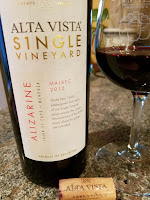 2012 Alta Vista Single Vineyard Alizarine
2012 Alta Vista Single Vineyard Alizarine ($50).
Alta Vista was the first Argentinian winery to produce single vineyard wines using a vineyard first planted in 1927 and located at 3,000 feet in Luján de Cuyo. This region was the first in Argentina to be officially recognized as an appellation and is situated in a valley just south of Mendoza City. The hot and dry climate helps produce delicious wine like this one here with notes of chocolate and dark fruit, good structure and very approachable tannins.
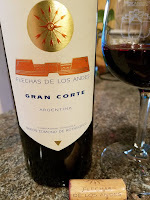 2012 Fleches De Los Andes Gran Corte
2012 Fleches De Los Andes Gran Corte ($45) This Malbec 60%, Cabernet Franc 20%, Syrah 20% blend is from
Tunuyán, located in the middle of the Valle de Uco on the eastern side of the valley. The alluvial soils are ideal for viticulture and the irrigation water is provided by the nearby river. The wine starts extremely tight and tannic so decant liberally. Once the wine opens baking spices and black pepper appear and the structured texture eventually evolves to create a deep and balancedl wine.
 2017 Altapaco Malbec Familia Schroeder Patagonia
2017 Altapaco Malbec Familia Schroeder Patagonia ($15) This wine from
Familia Schroeder is from San Patricio del Chanar, a new viticultural region in Patagonia, South America's southernmost wine-producing region. In geographic size, the region covers a vast area, nearly twice the size of California, across southern Argentina and Chile. The arid desert receives irrigation help from Andes melt water which flows through several rivers. "Vines stressed by these year-round high winds and the free-draining alluvial soils tend to grow smaller berries with thicker skins, leading to a higher concentration of sugars, acids and tannins". Alpataco refers to a thorny bush that the winery says "embodies the spirit of resilience needed to prosper in the Patagonian plains". This is a very fresh wine, with approachable and easy tannins that are preceded with bright red and tart cherry juice. Here's your everyday Malbec World Day wine. Cheers.






